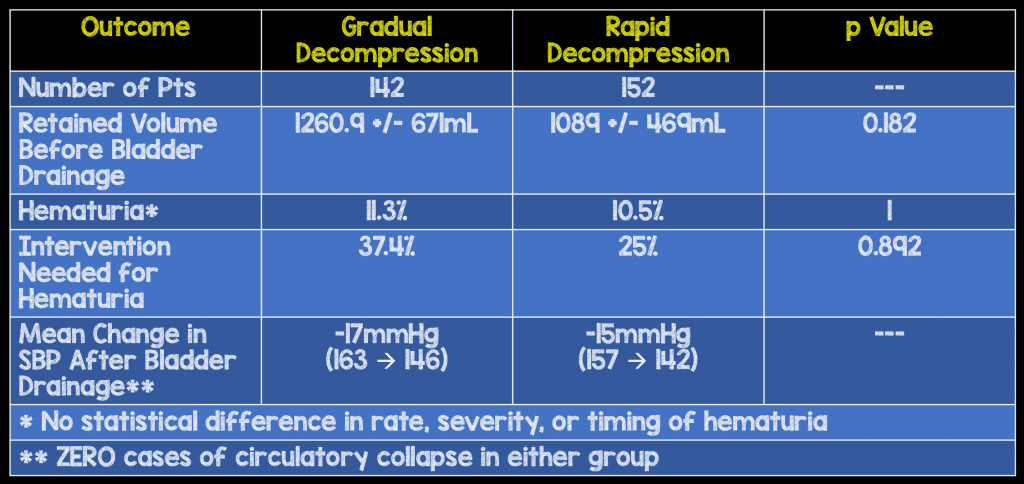
 Background: The treatment of urinary retention is pretty straightforward; place either a Foley catheter or suprapubic catheter to decompress the bladder. What is less clear, and more often debated, is if we need to clamp the catheter after 200 – 1000mLs of urine output or just allow complete drainage. Historic teaching has been to do intermittent volume drainage to avoid complications such as hematuria, circulatory collapse, and worsening renal failure. I distinctly remember being taught this as a resident, but not sure that I ever evaluated the literature until recently.
Background: The treatment of urinary retention is pretty straightforward; place either a Foley catheter or suprapubic catheter to decompress the bladder. What is less clear, and more often debated, is if we need to clamp the catheter after 200 – 1000mLs of urine output or just allow complete drainage. Historic teaching has been to do intermittent volume drainage to avoid complications such as hematuria, circulatory collapse, and worsening renal failure. I distinctly remember being taught this as a resident, but not sure that I ever evaluated the literature until recently.
What They Did:
- Prospective randomized trial of male patients with urinary obstruction were randomized to: Rapid Decompression (RD) vs Gradual Decompression (GD)
- GD = After every 200mL of urine drained catheter clamped for 5 min until bladder was completely empty
- RD = bladder drained completely by placing the foley bag to gravity
- After catheter placement patients monitored for at least 30 min with regular checks of VS, hematuria, and symptoms
Outcomes:
- Change in Vital Signs (Heart Rate and Blood Pressure)
- Hematuria
- Further Intervention/Treatment of Hematuria
Inclusion:
- Male patients presenting with symptoms of urinary retention (both acute and chronic)
- Able to give informed consent
Exclusion:
- Women
- Minors
- Patients with Urethral Strictures, Suprapubic catheters, and Preexisting Hematuria
Results:
- 294 patients enrolled into study
- GD: 142 (48.3%)
- RD: 152 (51.7%)

Strengths:
- Prospective Randomized Trial
- Baseline Characteristics of Patients Similar in Both Groups
- Kept track of confounding variables: age, anticoagulation treatment, history of urinary retention, previous urogenital surgery, and catheter material/size
- 1st study to quantify and compare the complication rate of GD vs RD of the bladder
Limitations:
- Unclear Primary Outcome
- How patients were randomized was not clear
- The duration of gradual drainage compared to rapid drainage was not recorded
- It is unclear how many patients had chronic vs acute urinary retention
- Blood pressure monitored via blood pressure cuff, which can be inaccurate
- Retained volume measured by using scale on drainage catheter bag. This technique may not be exact
- Data on pre-existing HTN was not recorded before decompression, making it hard to determine if elevated BP is due to urinary retention alone or just simply having primary benign HTN.
- Women excluded from this study: The authors state that urinary retention is very rare in women and typically the etiology is much more complex
Discussion:
- Depending on what source you read, initial decompression volumes and clamping times of the catheter can vary. The authors of this paper cite:
- Decompression Volumes: 500mL, 100 – 150mL, or 750mL
- Clamping Time: 30min
- It is worth mentioning that in the patients who required an intervention for hematuria (i.e. 10patients), all but one patient cleared with irrigation and ceased within 2 days. The one patient who did not clear, ended up with severe renal failure from chronic urinary retention, uremic platelet dysfunction, extended bleeding, and blood loss.
- Another assumed complication of RD is circulatory collapse due to viscerovascular reflexes. The authors state the reason for this collapse is, “the overdistended bladder leads to hypertension from increased arterial wall tonus and vasoconstricution throughout the sympathetic nerve mediated vesicovascular reflex.” And although this is possible, a better explanation may be that these patients are in pain from the urinary retention, which raises their blood pressure. When the painful stimulus is removed, blood pressure decreases.
Author Conclusion: “In this first randomized trial, no statistically significant difference was noted between gradual and rapid emptying of the bladder for urinary retention. Gradual emptying did not reduce the risk of hematuria or circulatory collapse. Therefore, there is no need to prefer gradual over rapid emptying, which is both easy and safe.”
Clinical Take Home Point: Rapid drainage of the bladder in urinary retention does not cause more hematuria requiring intervention, renal failure, or hemodynamic collapse compared to gradual drainage of the bladder.
References:
- Boettcher S et al. Urinary Retention: Benefit of Gradual Bladder Decompression – Myth or Truth? A Randomized Controlled Trial. Urol Int 2013; 91: 140 – 144. PMID: 23859894
Post Peer Reviewed By: Anand Swaminathan (Twitter: @EMSwami)
The post Urinary Retention: Rapid Drainage or Gradual Drainage to Avoid Complications? appeared first on REBEL EM - Emergency Medicine Blog.
